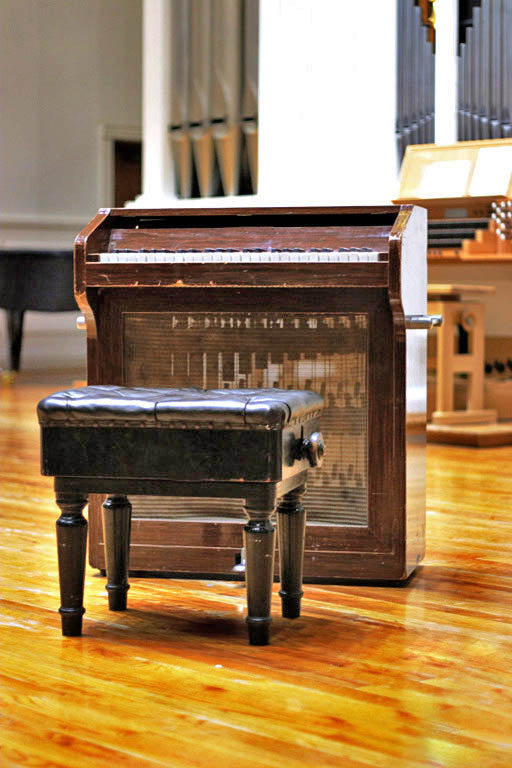I’m just writing this to explain the comment policy now. I’ve installed reCAPTCHA because books are awesome and also changed moderation, so that people who haven’t commented before have to get approved. If you have commented before and you use the same email, there should be no delay.
Author: Neil Flanagan
Good Architects: Esocoff & Associates
-

Ten Ten Massachusetts Avenue. From Home and Design Magazine.
DC architecture is known for being a little bland and generic. This reputation is not undeserved; there is something in the air since the early 20th century that has caused a stodgy vibe to persist like swamp gas over the city. Beaux-arts to glass-box, anywhere architecture has replaced the unique red city that was once gave DC a humble energy. In particular, the buildings of Adolph Cluss defined the aesthetic character of the city in a bright, practical way. Cluss’s South German heritage led him to design red brick buildings with vibrant decoration, like the Arts and Industries building, that differentiated DC from anywhere else in the country.
The firm of Esocoff & Associates has sort of picked up on his spirit, although they seem less interested in socialism than he. I remember in college returning home from Union Station, dreading the new, gray buildings or quasi-historicist schlock left over from the 90s, and driving down Mass Ave and being startled by the bright cobalt blue mullions of Post Massachusetts Avenue, surrounded by the warm umber brick. It took me a while to figure out who the firm was, and in that time they have built many more residential buildings that are post-modern in the best way, definitely reflecting contemporary values and modern construction, while being context-sensitive, humanistic, and unique. In particular, the Dumont’s sensual and explosive curves break the box with such bravado, it has stopped me on the street. Their handling of color and material is also fantastic.
They have repeated a distinctive style, sure, but haven’t exhausted its possibilities. I believe that their buildings will last as defining architecture of the period. I wish them the best of luck, because with time Esocoff could be come the new Cluss: an architect for the daily lives of the residents of the District of Columbia. God knows we need one.
Klingle Road is officially gone.
A Metrorail 20-year plan.
More explanation after the break…
Wikiglean II

For this month of December, when everyone is subjected to the ceaseless repetition of the Dance of the Sugar Plum Fairy, I offer this list of other un-famous classical pieces you probably already know.
- Delibe: The Flower Duet, (Youtube) from Lakmé really demonstrates Léo Delibes’s ability to write gorgeous melodies. Also to sell chocolates on airplanes. A real renaissance man. (Youtube)
- Of course you’ve heard this (supposedly) Bach organ piece in every horror comedy and weekday nights on MSNBC sometime between 9-10PM EST, bud did you know its status as BWV 565 is in doubt because it contains consecutive fifths and it is scientific fact that Bach can do no wrong…? (Youtube)
- Not as famous as the Messiah “Halelujah,” but the Händel coronation anthem “Zadok The Priest” still makes its way into popular culture occasionally. (Youtube)
- Most non-musicians also know the finale of the William Tell Overture, but also often heard but not well known is the “Ranz des Vaches” right before that, which is used regularly in, uh, Looney Tunes to set pastoral scenes. (Youtube – the more famous part at about 2:35)
- Similarly, the Grieg piece “Morning Mood” is used in cartoons and pop culture to indicate a peaceful morning. Interestingly, Grieg wrote it to represent the glory of the sun rising in Egypt. (Youtube) The piece is part of the Peer Gynt suite, which also includes the very famous “In the Hall of the Mountain King.”
- Also, if you’ve ever needed some latin flair, or dance music, you go for Libertango, by Astor Piazzolla. (Youtube). It is essentially the go-to song of modern tango.
Hot and fresh out the oven, it’s the Zeitgeist!
A bolt from Friedrich N.
Only owing to the seduction of language (and the fundamental errors of reason petrified within it, which conceives all effects as conditioned by something that causes effects, by a “subject,” can it appear otherwise. For just as the popular mind separates the lighting from its flash and takes the latter for an action, for the operation of a subject called lightning, so popular morality also separates strength from expressions of strength, as if there were an neutral substratum behind the strong man, which was free to express strength or not to do so. But there is no such substratum, there is no being behind doing, effecting, becoming; “the doer” is merely the fiction added to the deed – the deed is everything.
– from A Genealogy of Morals, first essay.


